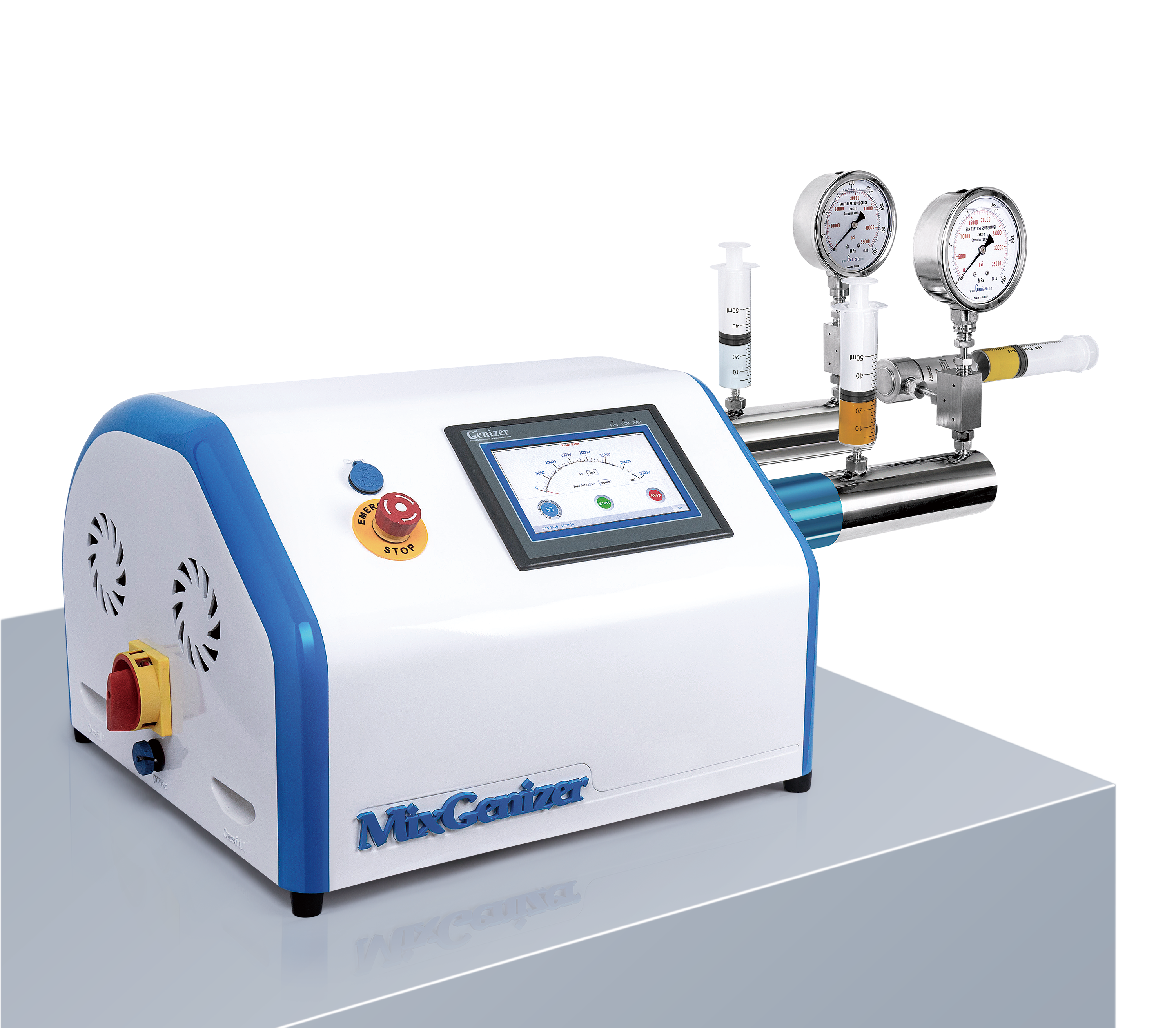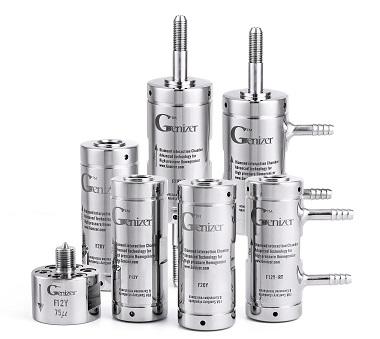When it comes to particle size reduction, emulsion formation, and cell disruption, two commonly used equipment options are high-pressure homogenizers (conventional valve homogenizers) and microfluidizer Homogenizers ( a cutting-edge high pressure microfluidic homogenizers). These technologies excel at achieving consistent particle size distribution and enhancing product quality across various industries. In this comparison, we will explore the differences between high-pressure homogenizers and microfluidizers, highlighting their unique features, advantages, and important considerations. By the end, you will have the knowledge needed to make an informed decision when selecting the appropriate equipment.
High-Pressure Homogenizers(conventional valve homogenizers):
High-pressure homogenizers are robust machines that utilize high pressure and mechanical forces to process materials. They consist of a piston-driven homogenizing valve, which propels the sample through a narrow gap, resulting in intense turbulence and shear forces. This process effectively breaks down particles, emulsifies liquids, and disrupts cells.
Advantages of High-Pressure Homogenizers:
Versatility: High-pressure homogenizers can handle a wide range of sample volumes, making them suitable for both small and large-scale production. This makes them well-suited for industrial-scale production where a significant amount of material needs to be processed. Additionally, they can process viscous liquids, suspensions, and emulsions with ease.
Microfluidizer Homogenizers (also known as high pressure microfluidic homogenizers):
Microfluidizers, on the other hand, utilize unique microfluidic diamond interaction chambers to achieve a uniform distribution of nanoparticles with pharmaceutical-grade quality. These chambers are specially designed with a fixed geometry that facilitates mechanical forces such as high shearing, high-frequency oscillation, cavitation, convective impact, and thermal effects. These combined effects induce changes in the physical, chemical, and particle structure of the materials, resulting in a more uniform and smaller nanoparticle size, ultimately achieving a superior homogenization effect. Microfluidizers find wide applications in the pharmaceutical, biotech, cosmetics, chemical, and diverse industries.
Genizer LLC is one of two companies in the world that supplies high pressure microfluidic homogenizers equipped with original microfluidic diamond interaction chambers. In recent years, Genizer’s microfluidic diamond interaction chambers have been equipped by more and more homogenizer manufacturer.
Advantages of Microfluidizer Homogenizers:
- Enhanced Efficiency: Microfluidizers are highly effective in achieving significant particle size reduction and superior homogenization efficiency. The precisely controlled fluid dynamics within the microchannels of the interaction chamber enable accurate manipulation of shear forces, resulting in precise and controlled particle size reduction and uniform particle distribution. Scalability: Microfluidizers offer seamless scalability, allowing for the smooth transition of research findings into large-scale production. This enables efficient technology transfer from laboratory-scale experimentation to industrial manufacturing processes.
- Scalability: Microfluidizers offer seamless scalability, facilitating the seamless transfer of research findings into large-scale production. This enables efficient technology transfer from laboratory-scale experimentation to industrial manufacturing processes.
- Reduced Heat Generation: Microfluidizers operate at lower pressures compared to high-pressure homogenizers, resulting in reduced heat generation during the process. This makes them suitable for heat-sensitive materials.
Making the Right Choice:
Choosing between a high-pressure homogenizer and a microfluidizer homogenizer depends on several factors. Consider the following key points to make an informed decision:
1. Application Requirements: Evaluate your specific application needs, including particle size requirements, sample viscosity, and desired throughput. Due to their advantages in price and resistance to clogging, high-pressure homogenizers are suitable for applications such as cell disruption, high-viscosity chemical materials, dairy beverages, inkjet pigments, and particle size reduction where high purity is not required. While Microfluidizer Homogenizers are commonly used in the field of nanoemulsion dispersion and high-value applications such as cosmetics, nano new materials, food, graphene, and pharmaceuticals (e.g., paclitaxel liposomes, docetaxel, propofol).
2. Sample Characteristics: Take into account the nature of your sample, including its heat sensitivity, fragility, and susceptibility to clogging. High-pressure homogenizers may be more suitable for robust samples, while microfluidizers are advantageous for heat-sensitive or delicate materials.
3. Production Scale: Assess your current and future production volumes and choose the technology that aligns with your production requirements. High-pressure homogenizers are generally more suitable for larger-scale production and applications that require higher throughput, while microfluidizers are better suited for smaller-scale production and applications that require more precise control over particle size and distribution.
4. Budget Considerations: Determine your budget and compare the costs associated with both equipment options, including upfront purchase costs, maintenance expenses, and operational costs. Consider the long-term return on investment (ROI) and the potential impact on product quality and process efficiency. The cost of a high-pressure homogenizer or microfluidizer can vary depending on the specific model and features. In general, the price of high-pressure homogenizers is lower than microfluidizers, especially for large-scale production. However, microfluidizers can offer cost savings in terms of reduced energy consumption, smaller dimensions and reduced material waste due to their ability to achieve more precise particle size reduction.
5. Expertise and Support: Evaluate the availability of technical expertise and after-sales support for the chosen equipment. Consider factors such as training, maintenance, and troubleshooting assistance provided by manufacturers or suppliers.
6. Future Needs and Flexibility: Anticipate any future requirements or potential changes in your production process. Choose a technology that allows for flexibility and adaptability to accommodate evolving needs.
In conclusion, when deciding between a high-pressure homogenizer and a microfluidizer homogenizer, several factors should be considered. High-pressure homogenizers are more suitable for industries with larger flow requirements and lower homogenization standards, such as the food and beverage, chemical, and generic pharmaceutical industries. On the other hand, microfluidizer homogenizers, such as NanoGenizer High Pressure Microfludic Homogenizer, are ideal for applications that demand higher performance and precision, such as the pharmaceutical, biotechnology, and cosmetics industries, as well as research laboratories and institutes that prioritize research quality. While high-pressure homogenizers offer a cost-effective solution, microfluidizer homogenizers provide enhanced efficiency and ease of use. Therefore, the choice should be based on specific application requirements and the desired level of homogenization quality.


